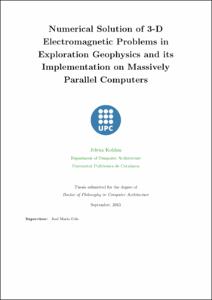Mostra el registre d'ítem simple
Numerical solution of 3-D electromagnetic problems in exploration geophysics and its implementation on massively parallel computers
| dc.contributor | Cela Espín, José M. |
| dc.contributor.author | Koldan, Jelena |
| dc.contributor.other | Universitat Politècnica de Catalunya. Departament d'Arquitectura de Computadors |
| dc.date.accessioned | 2014-02-17T12:58:56Z |
| dc.date.available | 2014-02-17T12:58:56Z |
| dc.date.issued | 2013-10-30 |
| dc.identifier.citation | Koldan, J. Numerical solution of 3-D electromagnetic problems in exploration geophysics and its implementation on massively parallel computers. Tesi doctoral, UPC, Departament d'Arquitectura de Computadors, 2013. DOI 10.5821/dissertation-2117-95162. |
| dc.identifier.uri | http://hdl.handle.net/2117/95162 |
| dc.description.abstract | The growing significance, technical development and employment of electromagnetic (EM) methods in exploration geophysics have led to the increasing need for reliable and fast techniques of interpretation of 3-D EM data sets acquired in complex geological environments. The first and most important step to creating an inversion method is the development of a solver for the forward problem. In order to create an efficient, reliable and practical 3-D EM inversion, it is necessary to have a 3-D EM modelling code that is highly accurate, robust and very fast. This thesis focuses precisely on this crucial and very demanding step to building a 3-D EM interpretation method. The thesis presents as its main contribution a highly accurate, robust, very fast and extremely scalable numerical method for 3-D EM modelling in geophysics that is based on finite elements (FE) and designed to run on massively parallel computing platforms. Thanks to the fact that the FE approach supports completely unstructured tetrahedral meshes as well as local mesh refinements, the presented solver is able to represent complex geometries of subsurface structures very precisely and thus improve the solution accuracy and avoid misleading artefacts in images. Consequently, it can be successfully used in geological environments of arbitrary geometrical complexities. The parallel implementation of the method, which is based on the domain decomposition and a hybrid MPI-OpenMP scheme, has proved to be highly scalable - the achieved speed-up is close to the linear for more than a thousand processors. Thanks to this, the code is able to deal with extremely large problems, which may have hundreds of millions of degrees of freedom, in a very efficient way. The importance of having this forward-problem solver lies in the fact that it is now possible to create a 3-D EM inversion that can deal with data obtained in extremely complex geological environments in a way that is realistic for practical use in industry. So far, such imaging tool has not been proposed due to a lack of efficient, parallel FE solutions as well as the limitations of efficient solvers based on finite differences. In addition, the thesis discusses physical, mathematical and numerical aspects and challenges of 3-D EM modelling, which have been studied during my research in order to properly design the presented software for EM field simulations on 3-D areas of the Earth. Through this work, a physical problem formulation based on the secondary Coulomb-gauged EM potentials has been validated, proving that it can be successfully used with the standard nodal FE method to give highly accurate numerical solutions. Also, this work has shown that Krylov subspace iterative methods are the best solution for solving linear systems that arise after FE discretisation of the problem under consideration. More precisely, it has been discovered empirically that the best iterative method for this kind of problems is biconjugate gradient stabilised with an elaborate preconditioner. Since most commonly used preconditioners proved to be either unable to improve the convergence of the implemented solvers to the desired extent, or impractical in the parallel context, I have proposed a preconditioning technique for Krylov methods that is based on algebraic multigrid. Tests for various problems with different conductivity structures and characteristics have shown that the new preconditioner greatly improves the convergence of different Krylov subspace methods, which significantly reduces the total execution time of the program and improves the solution quality. Furthermore, the preconditioner is very practical for parallel implementation. Finally, it has been concluded that there are not any restrictions in employing classical parallel programming models, MPI and OpenMP, for parallelisation of the presented FE solver. Moreover, they have proved to be enough to provide an excellent scalability for it. |
| dc.format.extent | 136 p. |
| dc.language.iso | eng |
| dc.publisher | Universitat Politècnica de Catalunya |
| dc.rights | L'accés als continguts d'aquesta tesi queda condicionat a l'acceptació de les condicions d'ús establertes per la següent llicència Creative Commons: http://creativecommons.org/licenses/by-nc-nd/3.0/es/ |
| dc.rights.uri | http://creativecommons.org/licenses/by-nc-nd/3.0/es/ |
| dc.source | TDX (Tesis Doctorals en Xarxa) |
| dc.subject | Àrees temàtiques de la UPC::Informàtica |
| dc.title | Numerical solution of 3-D electromagnetic problems in exploration geophysics and its implementation on massively parallel computers |
| dc.type | Doctoral thesis |
| dc.subject.lemac | Electromagnetisme -- Models matemàtics |
| dc.identifier.doi | 10.5821/dissertation-2117-95162 |
| dc.identifier.dl | B 6151-2014 |
| dc.rights.access | Open Access |
| dc.description.version | Postprint (published version) |
| dc.identifier.tdx | http://hdl.handle.net/10803/130833 |
Fitxers d'aquest items
Aquest ítem apareix a les col·leccions següents
-
Departament d'Arquitectura de Computadors [360]
-
Totes les tesis [5.446]


